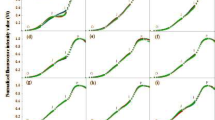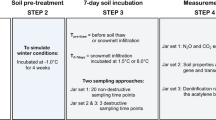Abstract
To study the single and combined effects of elevated carbon dioxide (CO2), ozone (O3), nitrogen nutrition, and water supply on photosynthetic gas exchange and biomass accumulation of Norway spruce, a four-factorial experiment was conducted in closed environmental chambers. Each factor was applied at two levels: (i) ambient and elevated (ambient + 200 μl 1-1) CO2, (ii) 20 and 80 nl 1-1 O3, (iii) low and high nitrogen fertilization, and (iv) a well watered and a drought treatment. Neither elevated O3 nor CO2 significantly changed stomatal conductances of spruce needles. Adverse effects of elevated O3 on photosynthetic parameters such as net assimilation rate and carboxylation efficiency occurred only when the plants were well watered and in a good nutritional status. After 6 weeks enhanced atmospheric CO2 resulted in increased net assimilation rates provided that nutrition was well balanced and plants were well watered. Acclimation processes became apparent and are interpreted as a consequence of sink regulation. While O3-effects were apparent only in biomass of 1-year-old plant material, elevated CO2 resulted in higher biomass of the buds expanding during the exposure and increased root biomass significantly. Above and below-ground biomass were strongly influenced by the water and nutrition treatments.
Similar content being viewed by others
References
Arp WJ (1991) Effects of source-sink relations on photosynthetic acclimation to elevated CO2. Plant Cell Environ 14: 869–875
Beadle CL, Jarvis PG, Neilson RE (1979) Leaf conductance as related to xylem water potential and carbon dioxide concentration in Sitka spruce. Physiol Plant 45: 158–166
Beyschlag W, Kresse F, Ryel R, Pfanz H (1994) Stomatal patchiness in conifers: experiments withPicea abies (L.) Karst. andAbies alba Mill. Trees 8: 132–138
Blank LW, Payer HD, Pfirrmann T, Gnatz G, Kloos M, Runkel K-H, Schmolke W, Strube D, Rehfuess KE (1990) Effects of ozone, acid mist and soil characteristics on clonal Norway spruce [Picea abies (L.) Karst.] — an introduction to the joint 14 month tree exposure experiment in closed chambers. In: Blank LW, Lütz C (eds) Tree exposure experiment in closed chambers. Environ Pollut 64: 189–207
Bowes G (1991) Growth at elevated CO2: photosynthetic responses mediated through Rubisco. Plant Cell Environ 14: 795–806
Caemmerer S von, Farquhar GD (1981) Some relationships between the biochemistry of photosynthesis and the gas exchange of leaves. Planta 153: 376–387
Ceulemans R, Mousseau M (1994) Effects of elevated CO2 on woody plants. New Phytol 127: 425–446
Chapin FS (1991) Effects of multiple environmental stresses on nutrient availability and use. In: Mooney HA, Winner WE, Pell EJ (eds) Response of plants to multiple stresses. Academic Press, London, pp 67–88
Conroy JP, Küppers M, Küppers B, Virgona J, Barlow EWR (1988) The influence of CO2 enrichment, phosphorus deficiency and water stress on the growth, conductance and water use ofPinus radiata D Don. Plant Cell Environ 11: 91–98
Dann MS, Pell EJ (1989) Decline of activity and quantity of ribulose bisphosphate carboxylase/oxygenase and net photosynthesis in O3-treated potato foliage. Plant Physiol 91: 427–432
Dannehl H, Herbik A, Godde D (1995) Stress-induced degradation of the photosynthetic apparatus is accompanied by changes in thylakoid protein turnover and phosphorylation. Physiol Plant 93: 179–186
Darrall NM (1989) The effect of air pollutants on physiological processes in plants. Plant Cell Environ 12: 1–30
DeLucia EH, Sasek T, Strain BR (1985) Photosynthetic inhibition after long-term exposure to elevated levels of atmospheric carbon dioxide. Photosyn Res 7: 175–184
Enquete-Kommission (1995) Mehr Zukunft für die Erde. Schlußbericht der Enquete-Kommission des 12. Deutschen Bundestages: Vorsorge zum Schutz der Erdatmosphäre. Economica, Karlsruhe
Führer G (1989) Photosyntheseverhalten, Transpiration und Spaltöff nungsregulation von Fichten (Picea abies) unter experimenteller Schadstoffbelastung in Expositionskammern. Doctoral thesis, University of Würzburg
Gates DM, Strain BR, Weber JA (1983) Ecophysiological effects of changing atmospheric CO2 concentration. In: Lange OL, Nobel PS, Osmond CB, Ziegler H (eds) Physiological plant ecology, IV. Springer, Berlin Heidelberg New York, pp 503–526
Geiger DR, Servaites JC (1991) Carbon allocation and response to stress. In: Mooney HA, Winner WE, Pell EJ (eds) Response of plants to multiple stresses. Academic Press, London, pp 103–127
Guderian R, Küppers K, Six R (1985) Wirkungen von Ozon, Schwefeldioxid und Stickstoffdioxid auf Fichte und Pappel bei unterschiedlicher Versorgung mit Magnesium und Kalzium sowie auf die BlattflechteHypogymnia physodes. VDI Berichte 560: 657–683
Gunderson CA, Wullschleger SD (1994) Photosynthetic acclimation in trees to rising atmospheric CO2: a broader perspective. Photosynth Res 39: 369–388
Hewitt CN, Lucas P, Wellburn AR, Fall R (1990) Chemistry of O3 damage to plants. Chem Ind (London): 478–481
Hüttl RF (1991) Die Nährelementversorgung geschädigter Wälder in Europa und Nordamerika. Freiburg Bodenk Abh 28
Kaupenjohann M, Zech W, Hantschel R, Horn R, Schneider BU (1989) Mineral nutrition of forest trees: a regional survey. In: Schulze E-D, Lange OL, Oren R (eds) Forest decline and air pollution. (Ecological studies, vol 77) Springer, Berlin Heidelberg New York, pp 282–296
Lange OL, Führer G, Gebel J (1986) Rapid field determination of photosynthetic capacity of cut spruce twigs (Picea abies) at saturating ambient CO2. Trees 1: 70–77
Lange OL, Heber U, Schulze E-D, Ziegler H (1989) Atmospheric pollutants and plant metabolism. In: Schulze E-D, Lange OL, Oren R (eds) Forest decline and air pollution. (Ecological studies, vol 77) Springer, Berlin Heidelberg New York, pp 238–273
Langebartels C, Heller W, Kerner K, Leonardi S, Rosemann D, Schraudner M, Trost M, Sandermann H Jr (1990) O3-induced defense reactions in plants. In: Payer H-D, Pfirrmann T, Mathy P (eds) Environmental research with plants in closed chambers. Air Pollut Res Rep EC 26: 358–368
Larcher W (1984) Ökologie der Pflanzen. UTB Eugen Ulmer, Stuttgart
Lehnherr B, Grandjean A, Mächler F, Fuhrer J (1987) The effect of O3 in ambient air on ribulosebisphosphate carboxylase/oxygenase activity decreases photosynthesis and grain yield in wheat. J Plant Physiol 130: 189–200
Linder S, Rook DA (1984) Effects of mineral nutrition on carbon dioxide exchange and partitioning of carbon in trees. In: Bowen GD, Nambiar EKS (eds) Nutrition of plantation forests. Academic Press, London, pp 211–236
Lippert M (1992) Multifaktorieller Ansatz zur Analyse der Langzeitwirkung erhöhter CO2-und Ozonkonzentrationen: Gaswechselmessungen an jungen Fichten und Buchen in Expositionskammern. Doctoral thesis, University of Würzburg
Matyssek R, Günthardt-Goerg MS, Saurer M, Keller T (1992) Seasonal growth, δ13C in leaves and stem, and phloem structure of birch (Betula pendula) under low O3 concentrations. Trees 6: 69–76
Matyssek R, Keller T, Koike T (1993) Branch growth and leaf gas exchange ofPopulus tremula exposed to low O3 concentrations throughout two growing seasons. Environ Pollut 79: 1–7
Mohr H (1994) Stickstoffeintrag als Ursache neuartiger Waldschäden. Spektrum der Wissenschaft, January, pp 48–53
Mooney HA, Winner WE, Pell EJ (1991) Preface. In: Mooney HA, Winner WE, Pell EJ (eds) Response of plants to multiple stresses. Academic Press, London, pp XIII-XIV
Morison JIL, Gifford RM (1984) Plant growth and water use with limited water supply in high CO2 concentrations. I. Leaf area, water use, and transpiration. Aust J Plant Physiol 11: 361–374
Oechel WC, Strain BD (1985) Native species responses to increased atmospheric carbon dioxide concentration. In: Strain BR, Cure JD (eds) Direct effects of increasing carbon dioxide on vegetation. DOE/ER-0238, US Department of Energy, Washington, D.C., pp 117–154
Oren R, Schulze E-D (1989) Nutritional disharmony and forest decline: A conceptual model. In: Schulze E-D, Lange OL, Oren R (eds), Forest decline and air pollution. (Ecological studies, vol 77) Springer, Berlin Heidelberg New York, pp 425–443
Oren R, Schulze E-D, Werk KS, Meyer J (1988) Performance of twoPicea abies (L.) Karst. stands at different stages of decline. VII. Nutrient relations and growth. Oecologia 77: 163–173
Payer HD, Blodow P, Köfferlein M, Lippert M, Schmolke W, Seckmeyer G, Seidlitz H, Strube D, Thiel S (1993) Controlled environment chambers for experimental studies on plant responses to CO2 and interactions with pollutants. In: Schulze E-D, Mooney HA (eds) Design and execution of experiments on CO2 enrichment. CEC, Brussels, pp 127–145
Pearson M, Mansfield TA (1993) Interacting effects of ozone and water stress on the stomatal resistance of beech (Fagus sylvatica L.). New Phytol 123: 351–358
Pell EJ, Pearson NS (1983) O3-induced reduction in quantity of ribulose-1,5-bisphosphate carboxylase in alfalfa foliage. Plant Physiol 73: 185–187
Pell EJ, Landry LG, Eckardt NA, Glick RE (1994) Air pollution and Rubisco: effects and implications. In: Alscher RG, Wellburn AR (eds) Plant responses to the gaseous environment. Chapman and Hall, London, pp 239–253
Pye JM (1988) Impact of O3 on the growth and yield of trees: a review. Environ Qual 17: 347–360
Rehfuess K-E, Bosch C, Pfannkuch E (1983) Nutrient imbalances in coniferous stands in southern Germany. Commun Inst For Fenn 116: 122–130
Reich PB (1987) Quantifying plant response to O3: a unifying theory. Tree Physiol 3: 63–91
Reich PB, Lassoie JP (1985) Influence of low concentrations of O3 on growth, biomass partitioning and leaf senescence in young hybrid poplar plants. Environ Pollut 39: 39–51
Runeckles VC, Chevone BI (1992) Crop responses to O3. In: Lefohn AS (eds) Surface level O3 exposures and their effect on vegetation. Lewis, Chelsea, Mich., pp 189–270
Schramel P (1988) ICP and DCP spectrometry for trace element analysis in biomedical and environmental samples. Spectrochim Acta 43: 881–896
Steffen I, Schramel P (1988) Bestimmung von Stickstoff in Fichtennadeln. Laborpraxis 12: 1354–1361
Stitt M (1991) Rising CO2 levels and their potential significance for carbon flow in photosynthetic cells. Plant Cell Environ 14: 741–762
Strain BR, Cure JD (1985) Status of knowledge and recommendations for future work. In: Strain BR, Cure JD (eds) Direct effects of increasing carbon dioxide on vegetation. DOE/ER-0238 US Department of Energy Washington D.C., pp 205–213
Thomas RB, Strain BR (1991) Root restriction as a factor in photosynthetic acclimation of cotton seedlings grown in elevated carbon dioxide. Plant Physiol 96: 627–634
Tissue DT, Oechel WC (1987) Response ofEriophorum vaginatum to elevated CO2 and temperature in the Alaskan tussock tundra. Ecology 68: 401–410
Tissue DT, Thomas RB, Strain BR (1993) Long-term effects of elevated CO2 and nutrients on photosynthesis and Rubisco in loblolly pine seedlings. Plant Cell Environ 16: 859–865
Tolley LC, Strain BR (1985) Effects of CO2 enrichment and water stress on gas exchange ofLiquidambar styraciflua andPinus taeda seedlings grown under different irradiance levels. Oecologia 65: 166–172
Van Oosten J-J, Afif D, Dizengremel P (1992) Long-term effects of a CO2 enriched atmosphere on enzymes of the primary carbon metabolism of spruce trees. Plant Physiol Biochem 30: 541–547
Wallin G (1990) On the impact of tropospheric O3 on photosynthesis and stomatal conductance of Norway spruce,Picea abies (L.) Karst. Thesis, University of Göteborg
Waring RH, Schlesinger WH (1985) Forest ecosystems. Concepts and management. Academic Press, London
Weikert RM, Wedler M, Lippert M, Schramel P, Lange OL (1989) Photosynthetic performance, chloroplast pigments, and mineral content of various needles age classes of spruce (Picea abies) with and without the new flush: an experimental approach for analysing forest decline phenomena. Trees 3: 161–172
Zöttl HW (1990) Ernährung und Düngung der Fichte. Forstw Cbl 109: 130–137
Author information
Authors and Affiliations
Rights and permissions
About this article
Cite this article
Lippert, M., Häberle, KH., Steiner, K. et al. Interactive effects of elevated CO2 and O3 on photosynthesis and biomass production of clonal 5-year-old Norway spruce [Picea abies (L.) Karst.] under different nitrogen nutrition and irrigation treatments. Trees 10, 382–392 (1996). https://doi.org/10.1007/BF02185642
Accepted:
Issue Date:
DOI: https://doi.org/10.1007/BF02185642




